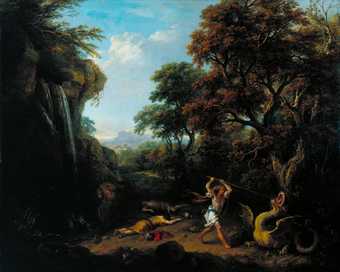Artist biography
Zuccarelli was one of the most highly acclaimed landscape painters of his day. He was considered in eighteenth-century Britain to be the most famous Italian painter then living. In addition to landscapes he also painted the occasional portrait and history picture.
Born in Pitigliano, Italy, he received his early training in Florence, where he engraved the frescoes by Andrea del Sarto in SS Annunziata. He studied in Rome, under Paolo Anesi and Giovanni Maria Morandi. From c.1730 he was active in Venice, where he was extensively patronised by British travellers and became friendly with Richard Wilson in 1750-1. He settled in London in October 1752, rapidly achieving great success with his Italianate landscapes. His work was frequently engraved. He designed a series of tapestries for Charles Wyndham, 2nd Earl of Egremont (c.1758, Petworth House, West Sussex, National Trust). On 16 February 1762 he held a sale of his own work, which contained over seventy items. He announced his intention to return to Italy once all the works were sold, returning to Venice on 11 November 1762. He became a member of the Venetian Academy the following year, but in February 1765 returned to England, where he received at least one commission from George III, Finding of Moses (1768, Royal Collection).
He became a founder member of the Royal Academy in 1768, exhibiting there 1769-71 and 1773. He also exhibited at the Free Society of Artists in 1765-6, and 1782, and at the Society of Artists in 1767-8. He returned to Venice in late 1771, and was elected President of the Venice Academy the following year. Shortly thereafter he retired to Florence, where he died.
The Tate owns a portrait of the artist by Richard Wilson (Tate Gallery N03727).
Further
reading:
M. Levey, 'Francesco Zuccarelli in England', Italian Studies, XIV, 1959, pp.1-20
E. Einberg and J. Egerton, The Age of Hogarth, Tate Gallery Collections: Volume Two, London 1988, pp.248-9
Jane Turner (ed.),
The Dictionary of Art, London and New York 1996, XXXIII, pp.714-16
Terry Riggs
January 1998
Wikipedia entry
Giacomo Francesco Zuccarelli (commonly known as Francesco Zuccarelli, Italian pronunciation: [franˈtʃesko ddzukkaˈrɛlli; ttsuk-]; 15 August 1702 – 30 December 1788) was an Italian artist of the late Baroque or Rococo period. He is considered to be the most important landscape painter to have emerged from his adopted city of Venice during the mid-eighteenth century, and his Arcadian views became popular throughout Europe and especially in England where he resided for two extended periods. His patronage extended to the nobility, and he often collaborated with other artists such as Antonio Visentini and Bernardo Bellotto. In 1768, Zuccarelli became a founding member of the Royal Academy of Arts, and upon his final return to Italy, he was elected president of the Venetian Academy. In addition to his rural landscapes which frequently incorporated religious and classical themes, Zuccarelli created devotional pieces and on occasion did portraiture. Besides paintings, his varied output included etchings, drawings, and designs for tapestries as well as a set of Old Testament playing cards.
Despite the fame he experienced in his lifetime, Zuccarelli's reputation declined in the early 19th century with naturalism becoming increasingly favoured in landscapes. Turner criticized him in mild terms while confessing that his figures could be beautiful, paving the way for more severe Victorian assessments. In 1959, the art historian Michael Levey offered suggestions for why Zuccarelli held such wide contemporary appeal among the English, concluding that his best work is highly decorative. More recently, since the 1990s there has been a renewed focus on Zuccarelli among Italian scholars, who have given him prominence in several books and articles, and his paintings and drawings are regularly shown in exhibitions.
This biography is from Wikipedia under an Attribution-ShareAlike Creative Commons License. Spotted a problem? Let us know.
Read full Wikipedia entry

